
Sixteen years before New York’s instantly celebrated High Line opened on the city’s west side, Paris inaugurated its own planted promenade, a strip of green cutting east-west through the 12th arrondissement along the path of the old train tracks of the Chemins de Fer de l’Est. The 3-mile long path of greenery called the Coulée Vert René-Dumont flows from near the Bastille to the Paris beltway, offering unexpected views of urban architecture along the way.
Before the tracks of the RER suburban line were laid, Parisians commuted to and from the suburbs via steam trains. On the east edge of the city, Vincennes-bound travelers boarded at the Bastille where a grandiose station, inaugurated in 1869, handled 30,000,000 passengers per year in the 1920s. The rise of the automobile diminished its use and the last train pulled out of the Bastille in 1969. While the Gare de la Bastille had a brief stay-of-execution through its transformation into a concert venue, it was razed in 1984 to make way for the Opéra Bastille.
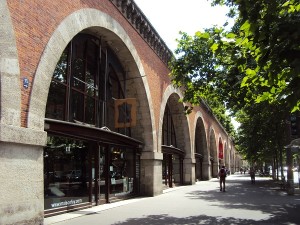 The Coulée Verte, loosely translated as the Green River, now follows the trace of the old rail tracks beginning behind the opera house. From there it snakes through the 12th arrondissement, a part of the city little explored by visitors, unless they might be visiting the Marché d’Aligre Beavau, one of the most vibrant food market areas (part indoor, part covered) of Paris, and its neighboring restaurants, cafés and wine bars.
The Coulée Verte, loosely translated as the Green River, now follows the trace of the old rail tracks beginning behind the opera house. From there it snakes through the 12th arrondissement, a part of the city little explored by visitors, unless they might be visiting the Marché d’Aligre Beavau, one of the most vibrant food market areas (part indoor, part covered) of Paris, and its neighboring restaurants, cafés and wine bars.
Setting out from the Bastille, the path is elevated along the old viaduct, now called the Viaduc des Arts, whose arches are home to elegant craft stores and workshops. Beyond the viaduct, the path lowers into a neighborhood park before winding its way through the varied urban landscape toward the edge of the city, occasionally branching out into broad picnic areas and playgrounds.
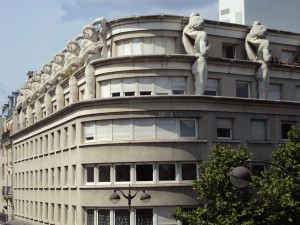 This variety adds spice to the trail since almost every conceivable approach to urban landscaping is tried and tested somewhere along the route. There are bird sanctuaries, bike paths, formal rose gardens and several stretches where weeds go wild. There’s everything but the kitchen sink. No, you actually can see kitchen sinks as you amble past people’s 4th floor windows on the elevated sections.
This variety adds spice to the trail since almost every conceivable approach to urban landscaping is tried and tested somewhere along the route. There are bird sanctuaries, bike paths, formal rose gardens and several stretches where weeds go wild. There’s everything but the kitchen sink. No, you actually can see kitchen sinks as you amble past people’s 4th floor windows on the elevated sections.
The most extraordinary architectural highlight offered by the Coulée Verte’s elevation is a view of the chorus line of Michelangelo slaves that adorn the top two floors of the Police Commissariat at 80 avenue Daumesnil. The building screams 1930, but it was designed by Barcelona-based architects Manuel Nunez-Yankowsky and Mirian Teitelbaum in 1991. The balcony apartments shadowed by those mighty stone thighs are reserved for police personnel.
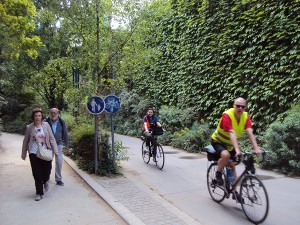 The Coulée Verte René-Dumont was originally called the Promenade Plantée, the Planted Promenade. In emphasizing its greenery it also took on the name of René Dumont, an agronomist and one of the fathers of France’s ecological political movement. Paris has a second Coulée Verte, the Coulée Verte du Sud Parisien, that’s especially worthwhile for leisure bikers. It begins toward the southern edge of the city, behind the Montparnasse Station, and extends nine miles to the suburb of Massy.
The Coulée Verte René-Dumont was originally called the Promenade Plantée, the Planted Promenade. In emphasizing its greenery it also took on the name of René Dumont, an agronomist and one of the fathers of France’s ecological political movement. Paris has a second Coulée Verte, the Coulée Verte du Sud Parisien, that’s especially worthwhile for leisure bikers. It begins toward the southern edge of the city, behind the Montparnasse Station, and extends nine miles to the suburb of Massy.
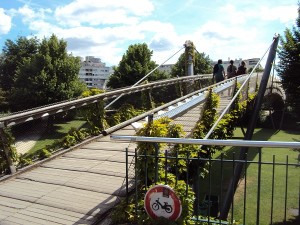 The Coulée Verte René-Dumont is partially bikable but only parts are truly bike-friendly. Walking shoes are the best bet here. This Coulée Verte is best approached via metro Bastille or Ledru Rollin. There are then a number of stair entrances up to the planted promenade on the viaduct. For an approach without stairs, the Coulée Verte is accessible via the entrance on rue Jacques Hillairet (near Metro Montgallet) and by the Surcouf elevator in the same general area.
The Coulée Verte René-Dumont is partially bikable but only parts are truly bike-friendly. Walking shoes are the best bet here. This Coulée Verte is best approached via metro Bastille or Ledru Rollin. There are then a number of stair entrances up to the planted promenade on the viaduct. For an approach without stairs, the Coulée Verte is accessible via the entrance on rue Jacques Hillairet (near Metro Montgallet) and by the Surcouf elevator in the same general area.
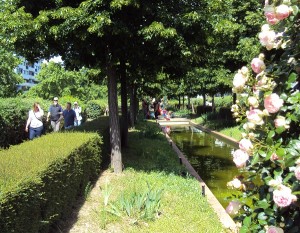 If you plan to wander hors piste for sustenance, Le Viaduc Café (43 avenue Daumesnil) makes for a fine pause for coffee or lunch. The above-mentioned Aligre Beauvau Market is also well worth a detour, particularly if you’d like to picnic along the Coulée Verte. The market (closed Mon.) is in fact a notable place to begin or end an exploration of this area.
If you plan to wander hors piste for sustenance, Le Viaduc Café (43 avenue Daumesnil) makes for a fine pause for coffee or lunch. The above-mentioned Aligre Beauvau Market is also well worth a detour, particularly if you’d like to picnic along the Coulée Verte. The market (closed Mon.) is in fact a notable place to begin or end an exploration of this area.
Train buffs may want to picnic in the newly renovated gardens of the Gare de Reuilly at 6 rue Dukas/181 avenue Daumesnil, a rare vestige of the old Vincennes line that has survived and that lives on as a neighborhood community center.
The Coulée Verte opens at 8am on weekdays, 9am on weekends and holidays. Closing times vary from 6pm to 9:30pm depending on the section and the season. See the City of Paris website for times.
Text and photos by Corinne LaBalme.

